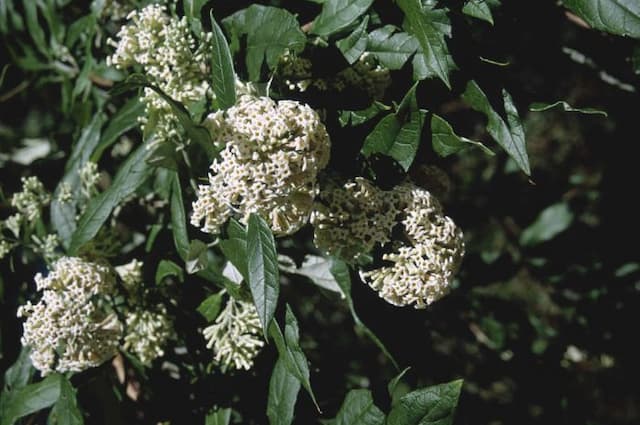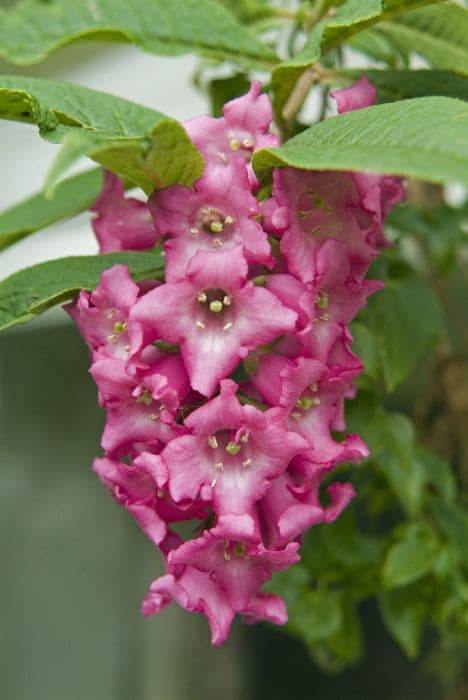Butterfly Bush Buddleja davidii 'Border Beauty'

ABOUT
The Butterfly Bush 'Border Beauty' is a deciduous shrub known for its attractive and fluffy flower spikes. The blooms are vibrant and typically range in shades of deep purple, presenting a magisterial display when in full blossom. Each flower cluster is elongated and tapers to a point, creating a mesmerizing effect as if the plant is covered in colorful, elongated cones. The flowers are often characterized by an alluring, sweet fragrance, which is highly effective at attracting butterflies and other beneficial pollinators, hence its common name. The foliage of the Butterfly Bush 'Border Beauty' contrasts nicely with the flowers. The leaves are green, lance-shaped, and exhibit a slightly wrinkled surface with a soft, fuzzy texture beneath. They are arranged in an opposite manner along the stems, providing a lush backdrop to the spectacular blooms. As the plant matures, its branches develop into an arching form, creating an elegant presence in the garden. When not in bloom, the Butterfly Bush still maintains visual interest thanks to its silvery-green leaves and the overall structure of the plant. Overall, the appearance of Butterfly Bush 'Border Beauty' is one of grace and vibrancy, bringing life and movement to garden settings with its blooms that appear to dance atop the foliage and invite the delightful flitter of butterflies throughout the flowering season.
About this plant
 Names
NamesSynonyms
Summer Lilac, Butterfly Bush, Orange Eye
Common names
Buddleja davidii 'Border Beauty'.
 Toxicity
ToxicityTo humans
Butterfly bush is considered non-toxic to humans. Therefore, ingestion is unlikely to cause any significant symptoms of poisoning or any severe consequences. It is always prudent, however, to avoid ingesting plants not meant for consumption, as individual sensitivities can vary.
To pets
Butterfly bush is also generally regarded as non-toxic to pets. Ingestion of the plant should not lead to symptoms of poisoning or serious health consequences in animals such as dogs and cats. However, as with humans, it is recommended to deter pets from consuming non-food plants to prevent any potential stomach upset or individual allergic reactions.
 Characteristics
CharacteristicsLife cycle
Perennials
Foliage type
Deciduous
Color of leaves
Green
Flower color
Purple
Height
6-8 feet (1.8-2.4 meters)
Spread
4-6 feet (1.2-1.8 meters)
Plant type
Shrub
Hardiness zones
5-9
Native area
China
Benefits
 General Benefits
General Benefits- Attracts Wildlife: The plant is known to attract butterflies, bees, and other pollinators to the garden, enhancing biodiversity.
- Easy to Grow: It is a hardy shrub that is relatively low maintenance and can thrive in a variety of soils and climates.
- Aesthetic Appeal: With its vibrant purple flowers, it adds color and visual interest to any garden landscape.
- Fast-Growing: Buddleja davidii 'Border Beauty' grows rapidly, making it a good choice for gardeners looking to quickly establish or fill in a space.
- Drought Tolerant: Once established, it has good resistance to drought, reducing the need for frequent watering.
- Screening: Its dense growth habit makes it useful for creating privacy screens or hedges in the garden.
- Long Flowering Period: The plant has a lengthy blooming season, often from early summer to autumn, providing extended enjoyment.
 Medical Properties
Medical Properties- This plant is not used for medical purposes.
 Air-purifying Qualities
Air-purifying QualitiesThis plant is not specifically known for air purifying qualities.
 Other Uses
Other Uses- Buddleja davidii 'Border Beauty', commonly known as Butterfly Bush, can be used in butterfly gardens to attract a variety of pollinators due to its nectar-rich flowers.
- Its dried flowers are used in potpourri mixes, adding a light, pleasant fragrance to a room when combined with other dried flowers and spices.
- Stems of the Butterfly Bush, when pruned in the winter, can be used to create plant supports for other, less sturdy garden plants in the following season.
- The plant's dense foliage can create an effective privacy screen in a garden or urban setting, growing quickly to provide cover.
- Artists and crafters may use the wood from pruned branches of the Butterfly Bush to create small woodcarvings or for use in rustic floral arrangements.
- With its rapid growth and branching habit, the Butterfly Bush can be trained as a standard, providing an ornamental tree-like form for patios and small gardens.
- The leaves of the Butterfly Bush can sometimes be used as a natural dye, creating subtle colors on fabrics when processed correctly.
- Butterfly Bush can also function as a living mulch, its dense growth suppressing weeds and retaining soil moisture when planted en masse.
- The Butterfly Bush's extensive root system can be employed for erosion control on slopes, helping to stabilize soil and prevent runoff.
- Buddleja davidii wood can be repurposed into rustic walking sticks or canes, with appropriate drying and finishing techniques.
Interesting Facts
 Feng Shui
Feng ShuiThe Butterfly Bush is not used in Feng Shui practice.
 Zodiac Sign Compitability
Zodiac Sign CompitabilityThe Butterfly Bush is not used in astrology practice.
 Plant Symbolism
Plant Symbolism- Hope - Buddleja davidii, commonly known as Butterfly Bush, is often associated with hope due to its ability to attract butterflies, symbolizing change and transformation.
- Renewal - The rapid growth and prolific blooming of the Butterfly Bush symbolize renewal and the continuous cycle of life.
- Encouragement - With its attractive and vibrant blooms that provide nourishment to butterflies, Butterfly Bush can symbolize encouragement and support to others.
- Attraction - The Butterfly Bush is known for its magnetic appeal to butterflies and bees, symbolizing attraction and charisma.
- Rebirth - As a plant that can recover even after harsh pruning, the Butterfly Bush also represents rebirth and resilience.
 Water
WaterFor the Butterfly Bush 'Border Beauty', it is essential to keep the soil consistently moist, especially during its first growing season to establish a deep, extensive root system. Watering should be done deeply rather than frequently, aiming for about an inch of water per week including rainfall. During dry spells or exceptionally hot weather, increase the watering to twice per week, applying approximately half a gallon to a gallon each time depending on the plant's size and soil conditions. Avoid overwatering as this can lead to root rot. Once established, Butterfly Bushes can tolerate some drought, but they thrive with regular watering and well-drained soil.
 Light
LightThe Butterfly Bush 'Border Beauty' performs best in full sunlight conditions, requiring at least six hours of direct sunlight each day to flourish. Ideally, plant it in a location where it can enjoy unfiltered sun throughout the day. A spot that receives morning sunlight with some afternoon shade is suitable, but be aware that too much shade can reduce blooming and lead to an increase in disease.
 Temperature
TemperatureThe Butterfly Bush 'Border Beauty' can tolerate a range of temperatures but performs best when the weather is between 60°F and 80°F. It is winter hardy down to about -10°F and can survive up to around 100°F in the summer. To ensure vigorous growth, plant it in an area where it will not be exposed to prolonged periods of temperatures outside this range. Mulching can help to maintain a steady root temperature.
 Pruning
PruningPrune the Butterfly Bush 'Border Beauty' annually in late winter or early spring to maintain its shape and to encourage the growth of new shoots that will produce flowers. Cut back the previous year's growth to about a foot or two from the ground. Doing so will also help prevent the plant from becoming too woody and will promote a more extensive bloom. Regularly deadhead the spent blooms throughout the growing season to encourage continued flowering.
 Cleaning
CleaningAs needed
 Soil
SoilThe Butterfly Bush requires well-draining, fertile soil with a pH range of 6.0 to 7.0. A standard mix would be one part peat, one part loam, and one part perlite or coarse sand for improved drainage.
 Repotting
RepottingButterfly Bushes typically do not need to be repotted often as they are generally grown outdoors. However, if grown in containers, they should be repotted every few years to refresh the soil and provide more room for growth.
 Humidity & Misting
Humidity & MistingButterfly Bush prefers outdoor conditions and does not require specific humidity levels, making it quite adaptable to various atmospheric moisture conditions.
 Suitable locations
Suitable locationsIndoor
Place in bright light and ensure sufficient space.
Outdoor
Full sun, well-drained soil, and space for growth.
Hardiness zone
5-9 USDA
 Life cycle
Life cycleBuddleja davidii 'Border Beauty', commonly known as Butterfly Bush, begins its life cycle with seed germination, occurring in early spring under favorable conditions of warmth and moisture. The seedlings emerge and grow rapidly, developing into shrubs with woody stems. The plant enters a stage of vegetative growth, producing lance-shaped leaves and preparing for the flowering phase. By mid to late summer, Butterfly Bush blooms profusely, showcasing conical clusters of fragrant, nectar-rich flowers that attract butterflies and other pollinators. After pollination, the flowers develop into small capsules of seeds which mature by late summer to autumn, before being released to start a new cycle. During winter in colder regions, the Butterfly Bush may die back to the ground, becoming dormant, then regrowing from its root system with the arrival of the next spring.
 Propogation
PropogationPropogation time
Spring-Early Summer
The Butterfly Bush (Buddleja davidii 'Border Beauty') can be propagated from semi-hardwood cuttings typically during the summer months when the plant is actively growing. One popular method begins with taking cuttings of about 4 to 6 inches (10-15 cm) in length from healthy, new growth. Each cutting should have several sets of leaves, and the lower set of leaves should be removed to expose the nodes. These cuttings are then dipped in rooting hormone to encourage root development and planted in a moist, well-draining potting mix. Covering the potted cuttings with a plastic bag to maintain humidity can create a greenhouse-like environment that promotes root growth. Roots typically develop within a few weeks, after which the new plants can be transplanted into individual pots or directly into the garden.

![Butterfly bush [Berries and Cream]](/_next/image?url=https%3A%2F%2Fplants-admin.emdemapps.com%2Fimages%2Fplants%2F%2Fimages%2F604b650f667be.png&w=640&q=75)






